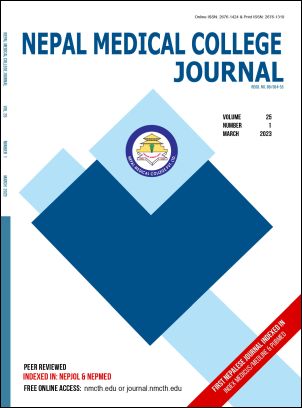Prevalence of Michel’s Type 1 hepatic arterial anatomy on CT angiography in Nepalese population
DOI:
https://doi.org/10.3126/nmcj.v25i1.53379Keywords:
Hepatic artery variant, Michel’s Type, MDCT angiographyAbstract
Multidetector Computed Tomography (MDCT), with an accuracy of 95-100%, is the modality of choice for preoperative assessment of hepatic artery anatomy in this era of modern hepatic surgeries. Celiac trunk is the first anterior branch of the abdominal aorta and trifurcates into left gastric, splenic, and common hepatic artery which branches into gastroduodenal and proper hepatic artery which then divides into right, middle and left hepatic arteries. Superior mesenteric artery (SMA) originates from abdominal aorta one centimeter below the celiac trunk. This “classic” anatomy pattern is seen only in approximately 61.3% of patients. This study aims at establishing prevalence of hepatic artery anatomical variations on MDCT in Nepalese population since such study has not been published in context of Nepal yet. Cross-sectional descriptive study was performed on MDCT images of all patients undergoing CT abdomen and pelvis with angiography between November 2018 and October 2022 (four years) at Nepal Medical College and Teaching Hospital. The Type of variation was categorized according to Michel’s classification. The values were further grouped under male and female categories. Data obtained was compiled and analyzed using SPSS 16. Out of 504 patients, 258 were males (51.2%) and 246 were females (48.8%). Youngest was nine years and the eldest was 93 years old with mean age of 48.1 years. The commonest variation was Michel’s Type 1, seen in 371 (73.6%) followed by Type 2 in 61 patients (12.1%) and Type 3 in 46 (9.1%). Type 4 was seen in 11 patients (2.2%) and Type 5 variant in nine patients (1.8%). Only one patient each had Type 6 and 7 (0.2 % each). Two had Type 9 (0.4%). We did not find Type 8 and 10. Statistically significant difference between male and female was found only in Type 2 with females having higher prevalence. Two patients showed celiac trunk and SMA arising from single celiomesenteric trunk of abdominal aorta, accounting for 0.4% of total cases which was tabled under unclassified category. MDCT is excellent modality to depict normal and variant hepatic arterial anatomy. Michel’s Type 1 is the commonest hepatic arterial anatomy variant and should be considered as normal “classic” pattern.
Downloads
Downloads
Published
How to Cite
Issue
Section
License
Copyright (c) 2023 Nepal Medical College Journal

This work is licensed under a Creative Commons Attribution 4.0 International License.
This license enables reusers to distribute, remix, adapt, and build upon the material in any medium or format, so long as attribution is given to the creator. The license allows for commercial use.




